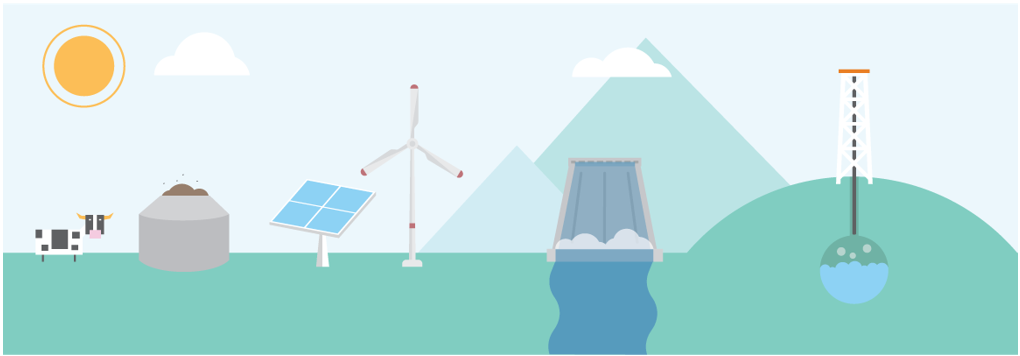
Biomass
Waste not, want not!
Biomass is any organic matter like trees, plants, or animal waste that can be used as an energy source. Energy comes from the sun through a process called photosynthesis and is released when biomass is burned or decomposes.
How It Works
Plant Waste
Leftover wood and crop waste from factories and farms can be burned to produce electricity.
- Wood scraps, sawdust and crop waste are collected from farms or manufacturing plants
- The waste is burned to heat water and create steam
- Steam is sent to a turbine, which spins to power a generator
- The generator creates electricity and sends to transmission lines
Biogas
Waste produced by cows or other farm animals creates a gas called methane, which can be captured to produce electricity.
- Animal waste is collected in a large tank or pond with bacteria
- As bacteria decomposes the waste (i.e. methane) is released
- Methane is then burned to heat water and generate steam
- Steam turns a generator turbine to create electricity, which is sent to transmission lines
Fun Facts:
Biomass is a renewable energy source because trees and crops can always be grown
Biomass has been around since the beginning of time when man burned wood for heating and cooking
If you’ve ever been near a campfire or a fireplace, you’ve witnessed biomass energy through the burning of wood.

Geothermal
From the inside out…
Geothermal energy is created using heat from the Earth’s core.
How It Works
- The Earth’s hot core creates magma and heats the Earth’s crust, which is made up of rocks and water
- A well drilled two miles deep into the Earth’s surface captures the rising hot water and steam
- The hot steam rises to the surface and pushes a turbine, which rotates a generator
- The generator produces electricity and sends it to power lines, which bring electricity to homes and businesses
Fun Facts:
The Earth’s core is hotter than the sun’s surface!
The United States is the leader in geothermal power generation, with geothermal power plants in seven states
Geothermal energy is a found in underground reservoirs, but also rises to the Earth’s surface in the form of volcanoes, hot springs and geysers.

Hydro
Tapping into water sources for energy.
Hydroelectric energy is generated using the power of moving water in our Earth’s rivers and oceans.
How It Works
- A dam blocks water from moving where it wants to naturally
- Instead, the water flows through a pipe to a turbine, then back out on the other side of the dam
- Turbines spin by force of water and rotate a generator
- The generator produces electricity and sends to power lines, bringing electricity to homes and businesses
Fun Facts
Hydropower is one of the least expensive renewable energy source in the United States
Hydropower can be captured from many different forms of water, including river currents, river dams, ocean waves, and ocean tide
Hydropower is one of the oldest sources of energy, used to grind grain by the Ancient Egyptians as early as 250 B.C.
Solar
The amazing power of the sun!
Solar energy is created from the sun’s powerful rays. Because sunlight is inexhaustible, solar energy is a valuable renewable energy source – capable of directly generating heat, light and electricity.
According to the U.S. National Renewable Energy Laboratories (NREL), the amount of energy from the sun that falls to the earth in one day could supply the entire world’s energy needs for 27 years!
Learn more about the benefits of solar energy, find out how to get solar installed on your home or power your home with solar electricity plans from Energyx .
How It Works
- Photovoltaic solar panels absorb the sun’s rays and convert them into energy
- A control device converts the energy from direct current (DC) electricity to alternating current (AC) electricity, which is capable of powering electrical items
- This electricity can be added to the electricity grid, which powers local homes and businesses
Fun Facts
The largest solar power plant in the world is located in California’s Mojave Desert and is made up of 173,500 mirrors that convert the sun’s heat into electricity
Solar energy can be used to heat water; power cars, aircrafts, calculators and other small appliances; and even cook food
It takes about 8 minutes for sunlight to travel from the sun to the earth, moving at 186,282 miles per second.

Wind
Fresh air makes the turbines go ’round!
Wind energy is the second-most common form of renewable energy used to make electricity in the U.S. It has grown at a rapid rate in recent years, and the U.S. Department of Energy has announced a goal of obtaining 6% of U.S. electricity from wind by 2020 (up from about 3% in 2012).
As public demand for clean energy grows and as the cost of producing energy from the wind continues to decline, wind energy will likely provide a growing portion of the nation’s energy supply.
Power your home with wind from Energyx Energy.
How It Works
Wind can be caught using large wind mills (called turbines) that spin to generate electricity.
- Computer systems control the direction of turbine blades to match the direction of the wind
- Wind pushes the turbine blades into rotation
- Blades turn a generator to convert mechanical energy into electricity
- The generator sends electricity through transmission lines to the power grid, bringing electricity to homes and businesses
Fun Facts
The top 5 wind power producing states, in order, are Texas, Iowa, California, Minnesota and Washington
Wind turbines can be as tall as a 20-story building, with blades as long as a football field
Wind has been used since the earliest civilizations to grind grain, pump water and power sailboats.
